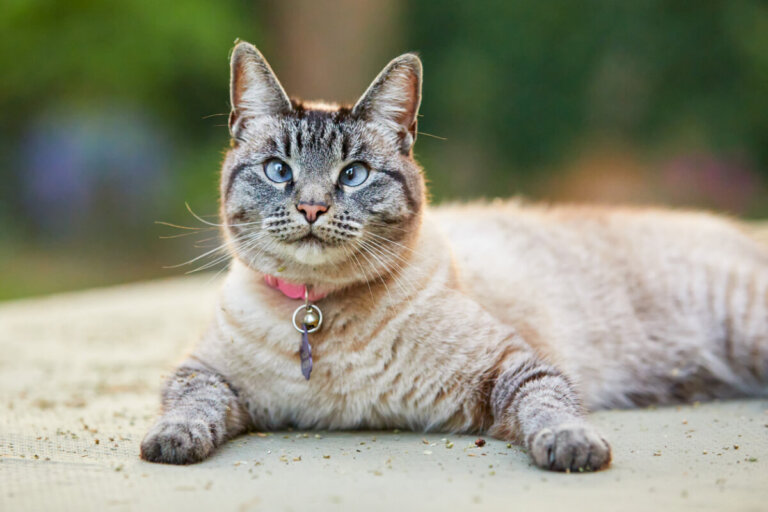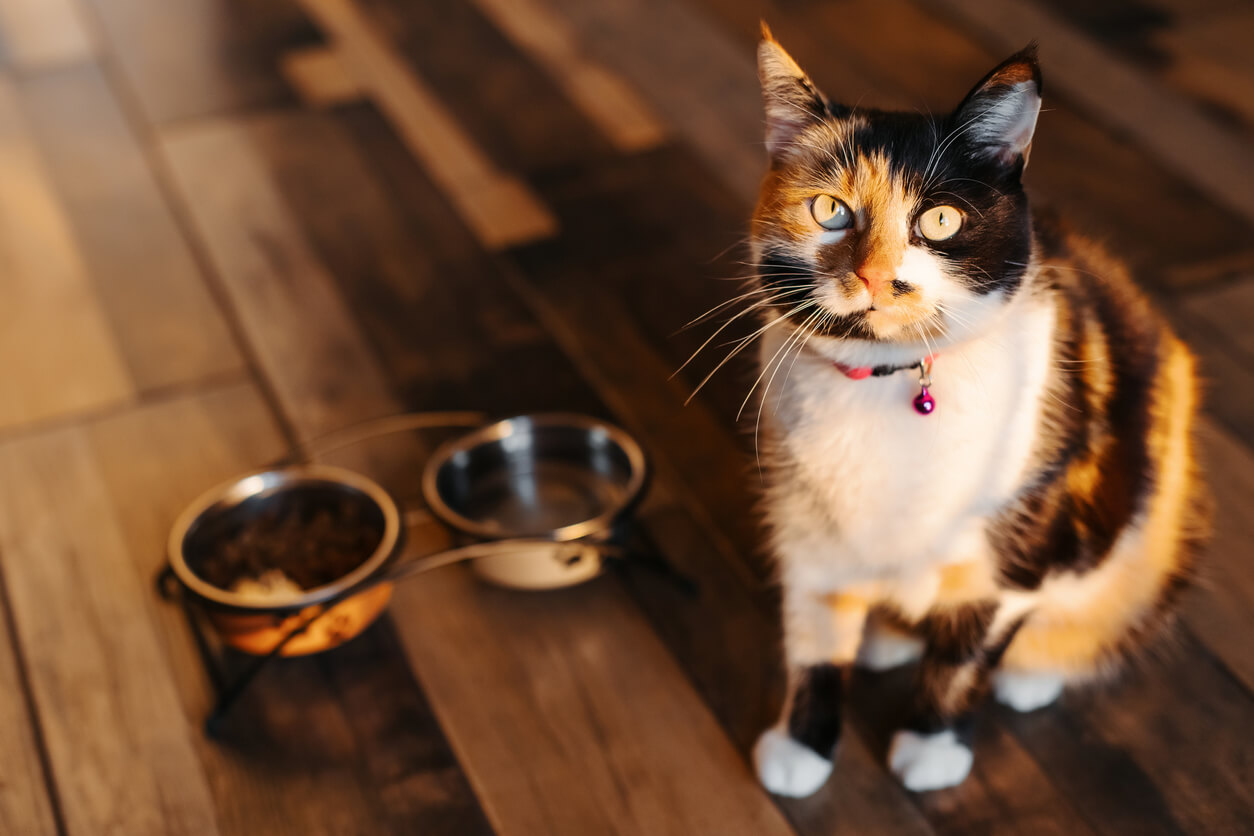Down Syndrome in Cats: Is It Possible?


Written and verified by the veterinarian and zootechnician Sebastian Ramirez Ocampo
Man’s influence on the genetics of domestic animals – through practices like inbreeding – has increased the risk of congenital diseases, which are manifested from the development of the fetus. With this in mind, is Down syndrome in cats possible?
In humans, one of the most important pathologies is Down syndrome. This condition is characterized by the physical and mental changes it generates in those who have it. However, due to the similarity of certain feline conditions with this syndrome, some people have suggested that cats can also present it.
Continue reading this content and find out if it’s possible for there to be cats with Down syndrome or if it’s another type of disease. Don’t miss this information about felines!
What’s Down syndrome?
In general, each human has a total of 23 pairs of chromosomes (46 chromosomes in total) in its genetic material. Of these, 22 are autosomes – numbered according to their size – and a last pair defines the sex: XX or XY (female or male, respectively).
During the fertilization process, half is provided by the mother and the other half by the father. However, as a publication in the journal Nature explains, Down syndrome presents an additional chromosome in the 21st pair.
This congenital anomaly -better known as trisomy 21- is considered to be the main genomic disorder associated with intellectual disability problems in humans.
It’s estimated that in Europe, it affects 4.9 individuals out of every 10,000, while in the United States, it amounts to 6.7 in the same number of inhabitants.
At the same time, according to an article in the journal Primates, some apes, such as the chimpanzee, also have Down syndrome. However, trisomy occurs in chromosome 22, which is considered homologous or similar to number 21 in humans.
Can cats have this syndrome?
Although some conditions may make one think that a cat has this syndrome, the reality is that, in biological terms, it’s impossible. In essence, cats with Down syndrome can’t exist, as this species has only 19 pairs of chromosomes in its genetic material.
Furthermore, according to a paper published in the journal Molecular and Cellular Probes, cats don’t have a fragile site on the X chromosome, such as to cause mental retardation. In addition, there’s no Down syndrome gene analog in felines, as the genes of human chromosome 21 are represented on the metacentric chromosome C2, which is different.
Therefore, neither the biological nor the genetic conditions are present for the anomaly to manifest itself in this animal species. In spite of this, cats aren’t exempt from suffering alterations in their chromosomes.
For example, there are felines with Klinefelter syndrome, where the males have an additional X chromosome. Consequently, they’re not XY but XXY. This pathology is characterized by infertility in males, and the display of three colors in their fur, an aspect exclusive to females under normal conditions.

Why has the possibility of Down syndrome in cats been considered?
This belief has spread because of the appearance of some felines with inherited diseases or that have suffered problems during pregnancy. Among the main signs that have led to the consideration of the existence of cats with Down syndrome are the following:
- Dwarfism
- Strabismus
- Microphthalmia
- Flattened face
- Low muscle tone
- Malformation of the nasal bone
- Difficulty coordinating movements
- Splayed and upward-curved eyes
While some of these signs are shared with humans who have Down syndrome, in cats, they occur as a consequence of other pathologies.
What conditions make a cat appear to have this syndrome?
According to the cited study in the journal Molecular and Cellular Probes, cats possess an estimated 35 genes containing more than 50 mutations related to health or appearance problems.
As an example, there are reports on the effects of selective breeding in the Burmese breed. The findings are revealing: About 25% of the offspring are born with physical malformations, such as the absence of nasal prominence.
However, genetic problems aren’t the only cause of structural faults in a cat.
According to the article Congenital Defects of Kittens, during pregnancy, certain situations can occur that produce physical and cognitive defects in the unborn feline. Of these, the most important are the following:
- Intrauterine infections: For example, mothers who become infected with the feline panleukopenia virus during pregnancy give birth to cats with cerebral hypoplasia. This condition causes the neonates to have poor control and coordination of their movements. In addition, they manifest tremors and swaying when walking.
- Medications: The administration of drugs -such as griseofulvin during pregnancy- causes cleft palate and other malformations in cats.
- Chemicals and environmental toxins: Pesticides, herbicides, and other chemical agents have teratogenic effects. Therefore, they can produce physical and cognitive abnormalities.
- Hyperthermia: Increased maternal body temperature during pregnancy can cause birth defects.
- Nutritional factors: Taurine deficiency is associated with musculoskeletal malformations in cats.
What if my cat is different from the rest?
If your pet has any of these physical or cognitive deformities, you can be sure that it’s not Down syndrome. In most cases, physical malformations don’t interfere with the normal development of a cat’s life, so they can perform the activities of a healthy feline.
However, if the defect affects their mobility, they may require special care. For example, the animal should be prevented from reaching high surfaces. The purpose of this recommendation is to reduce the risk of a fall and trauma that could compromise its welfare.
Likewise, check-ups with the veterinarian should be constant in order to ensure that the condition doesn’t compromise vital organs. In any case, like any pet, it’ll require attention, care, and love from its guardian.
Man’s influence on the genetics of domestic animals – through practices like inbreeding – has increased the risk of congenital diseases, which are manifested from the development of the fetus. With this in mind, is Down syndrome in cats possible?
In humans, one of the most important pathologies is Down syndrome. This condition is characterized by the physical and mental changes it generates in those who have it. However, due to the similarity of certain feline conditions with this syndrome, some people have suggested that cats can also present it.
Continue reading this content and find out if it’s possible for there to be cats with Down syndrome or if it’s another type of disease. Don’t miss this information about felines!
What’s Down syndrome?
In general, each human has a total of 23 pairs of chromosomes (46 chromosomes in total) in its genetic material. Of these, 22 are autosomes – numbered according to their size – and a last pair defines the sex: XX or XY (female or male, respectively).
During the fertilization process, half is provided by the mother and the other half by the father. However, as a publication in the journal Nature explains, Down syndrome presents an additional chromosome in the 21st pair.
This congenital anomaly -better known as trisomy 21- is considered to be the main genomic disorder associated with intellectual disability problems in humans.
It’s estimated that in Europe, it affects 4.9 individuals out of every 10,000, while in the United States, it amounts to 6.7 in the same number of inhabitants.
At the same time, according to an article in the journal Primates, some apes, such as the chimpanzee, also have Down syndrome. However, trisomy occurs in chromosome 22, which is considered homologous or similar to number 21 in humans.
Can cats have this syndrome?
Although some conditions may make one think that a cat has this syndrome, the reality is that, in biological terms, it’s impossible. In essence, cats with Down syndrome can’t exist, as this species has only 19 pairs of chromosomes in its genetic material.
Furthermore, according to a paper published in the journal Molecular and Cellular Probes, cats don’t have a fragile site on the X chromosome, such as to cause mental retardation. In addition, there’s no Down syndrome gene analog in felines, as the genes of human chromosome 21 are represented on the metacentric chromosome C2, which is different.
Therefore, neither the biological nor the genetic conditions are present for the anomaly to manifest itself in this animal species. In spite of this, cats aren’t exempt from suffering alterations in their chromosomes.
For example, there are felines with Klinefelter syndrome, where the males have an additional X chromosome. Consequently, they’re not XY but XXY. This pathology is characterized by infertility in males, and the display of three colors in their fur, an aspect exclusive to females under normal conditions.

Why has the possibility of Down syndrome in cats been considered?
This belief has spread because of the appearance of some felines with inherited diseases or that have suffered problems during pregnancy. Among the main signs that have led to the consideration of the existence of cats with Down syndrome are the following:
- Dwarfism
- Strabismus
- Microphthalmia
- Flattened face
- Low muscle tone
- Malformation of the nasal bone
- Difficulty coordinating movements
- Splayed and upward-curved eyes
While some of these signs are shared with humans who have Down syndrome, in cats, they occur as a consequence of other pathologies.
What conditions make a cat appear to have this syndrome?
According to the cited study in the journal Molecular and Cellular Probes, cats possess an estimated 35 genes containing more than 50 mutations related to health or appearance problems.
As an example, there are reports on the effects of selective breeding in the Burmese breed. The findings are revealing: About 25% of the offspring are born with physical malformations, such as the absence of nasal prominence.
However, genetic problems aren’t the only cause of structural faults in a cat.
According to the article Congenital Defects of Kittens, during pregnancy, certain situations can occur that produce physical and cognitive defects in the unborn feline. Of these, the most important are the following:
- Intrauterine infections: For example, mothers who become infected with the feline panleukopenia virus during pregnancy give birth to cats with cerebral hypoplasia. This condition causes the neonates to have poor control and coordination of their movements. In addition, they manifest tremors and swaying when walking.
- Medications: The administration of drugs -such as griseofulvin during pregnancy- causes cleft palate and other malformations in cats.
- Chemicals and environmental toxins: Pesticides, herbicides, and other chemical agents have teratogenic effects. Therefore, they can produce physical and cognitive abnormalities.
- Hyperthermia: Increased maternal body temperature during pregnancy can cause birth defects.
- Nutritional factors: Taurine deficiency is associated with musculoskeletal malformations in cats.
What if my cat is different from the rest?
If your pet has any of these physical or cognitive deformities, you can be sure that it’s not Down syndrome. In most cases, physical malformations don’t interfere with the normal development of a cat’s life, so they can perform the activities of a healthy feline.
However, if the defect affects their mobility, they may require special care. For example, the animal should be prevented from reaching high surfaces. The purpose of this recommendation is to reduce the risk of a fall and trauma that could compromise its welfare.
Likewise, check-ups with the veterinarian should be constant in order to ensure that the condition doesn’t compromise vital organs. In any case, like any pet, it’ll require attention, care, and love from its guardian.
All cited sources were thoroughly reviewed by our team to ensure their quality, reliability, currency, and validity. The bibliography of this article was considered reliable and of academic or scientific accuracy.
- Antonarakis, S. E., Skotko, B. G., Rafii, M. S., Strydom, A., Pape, S. E., Bianchi, D. W., Sherman, S. L., & Reeves, R. H. (2020). Down syndrome. Nature reviews. Disease Primers, 6(1), 9. https://www.ncbi.nlm.nih.gov/pmc/articles/PMC8428796/
- Hirata, S., Hirai, H., Nogami, E., Morimura, N., & Udono, T. (2017). Chimpanzee Down syndrome: a case study of trisomy 22 in a captive chimpanzee. Primates, 58(2), 267–273. https://link.springer.com/article/10.1007/s10329-017-0597-8
- Little, S. (2005). Congenital Defects of Kittens. Tufts’ Canine and Feline Breeding and Genetics Conference. https://www.vin.com/apputil/content/defaultadv1.aspx?id=3853844&pid=11203
- Lyons L. A. (2012). Genetic testing in domestic cats. Molecular and Cellular Probes, 26(6), 224–230. https://www.ncbi.nlm.nih.gov/pmc/articles/PMC3541004/
- Noden, D. M., & Evans, H. E. (1986). Inherited homeotic midfacial malformations in Burmese cats. Journal of craniofacial genetics and developmental biology. Supplement, 2, 249–266. https://pubmed.ncbi.nlm.nih.gov/2878018/
- Pedersen, A. S., Berg, L. C., Almstrup, K., & Thomsen, P. D. (2014). A tortoiseshell male cat: chromosome analysis and histologic examination of the testis. Cytogenetic and Genome Research, 142(2), 107–111. https://karger.com/cgr/article-abstract/142/2/107/61905/A-Tortoiseshell-Male-Cat-Chromosome-Analysis-and?redirectedFrom=fulltext
- Saraiva, I. Q., & Delgado, E. (2020). Congenital ocular malformations in dogs and cats: 123 cases. Veterinary Ophthalmology, 23(6), 964–978. https://onlinelibrary.wiley.com/doi/10.1111/vop.12836
This text is provided for informational purposes only and does not replace consultation with a professional. If in doubt, consult your specialist.








